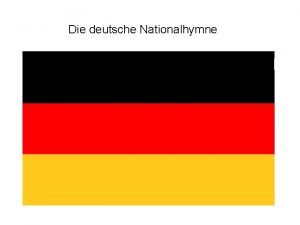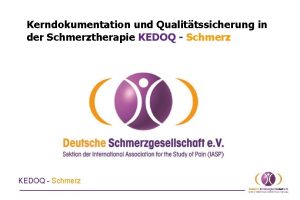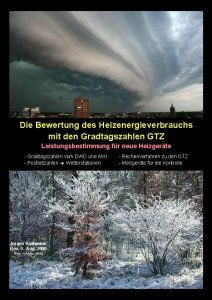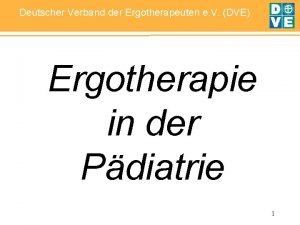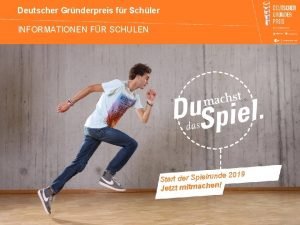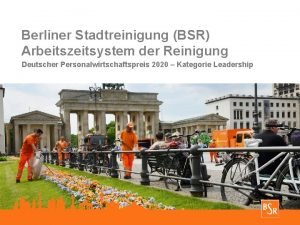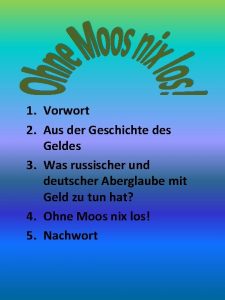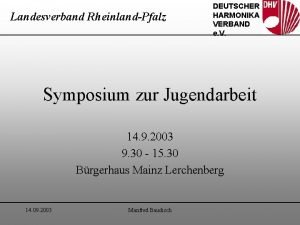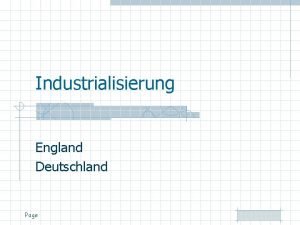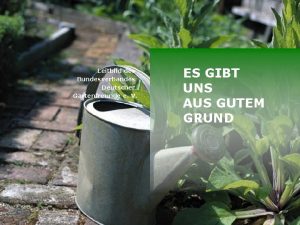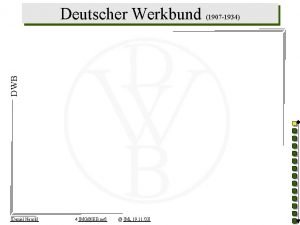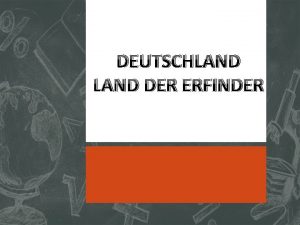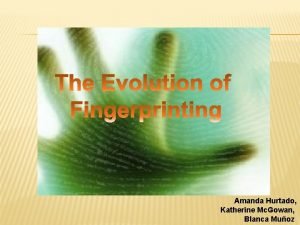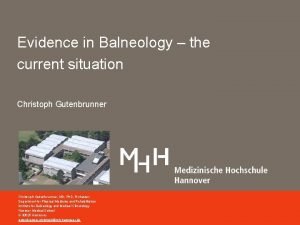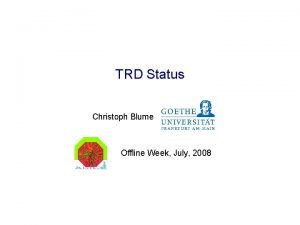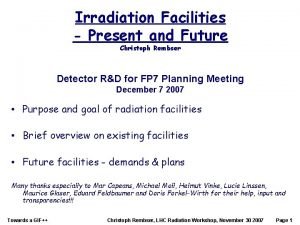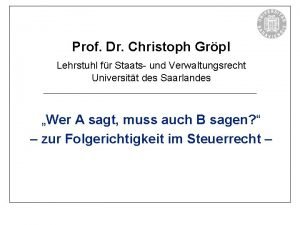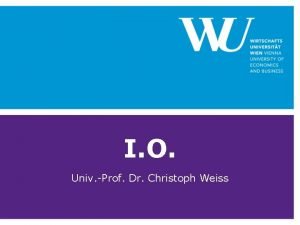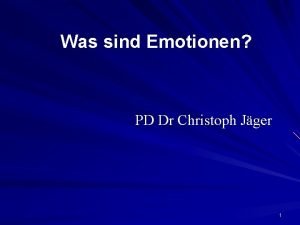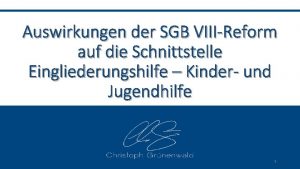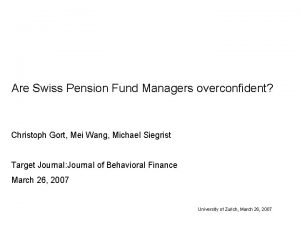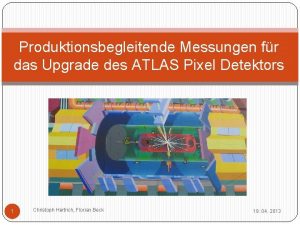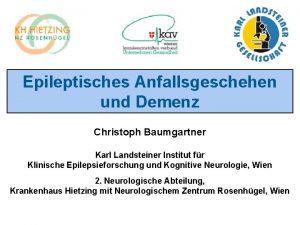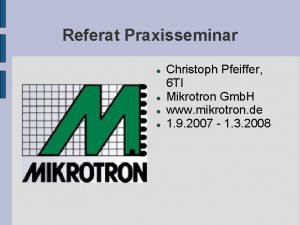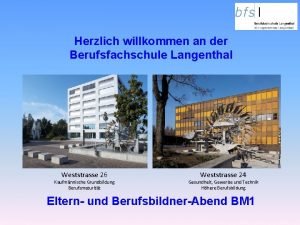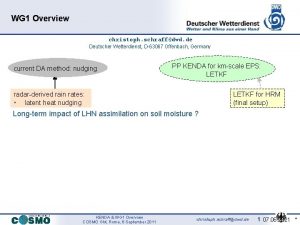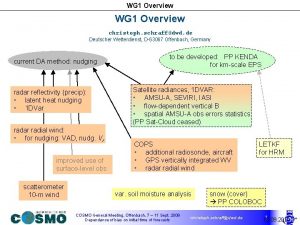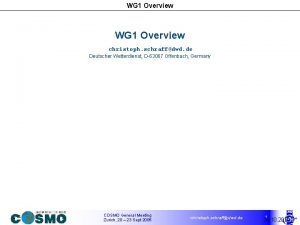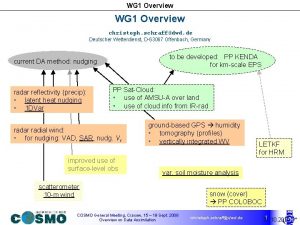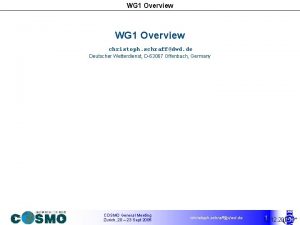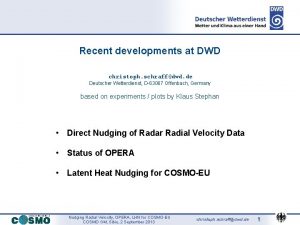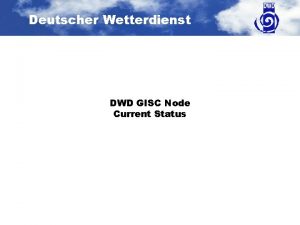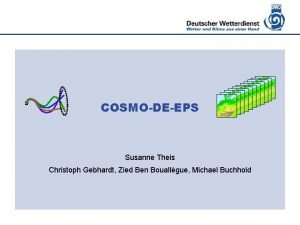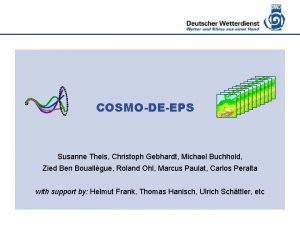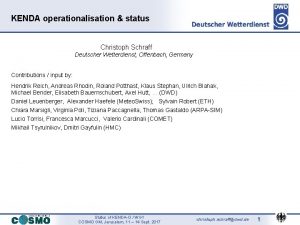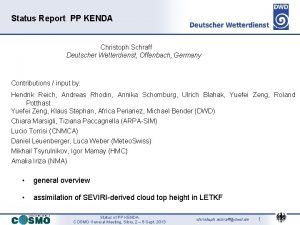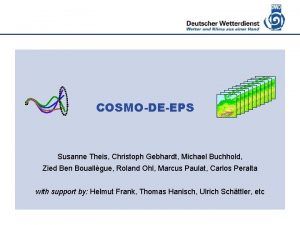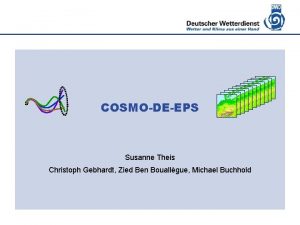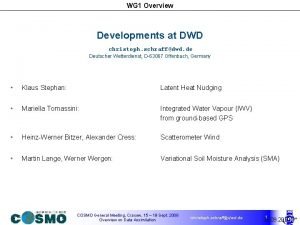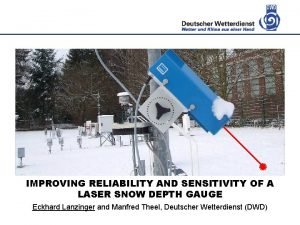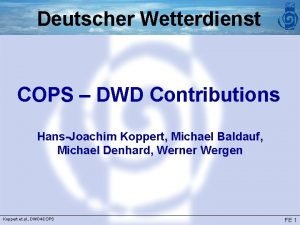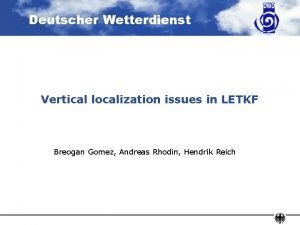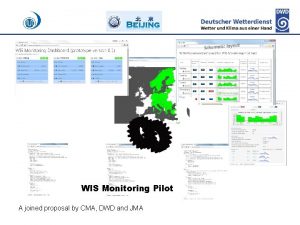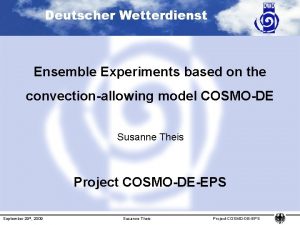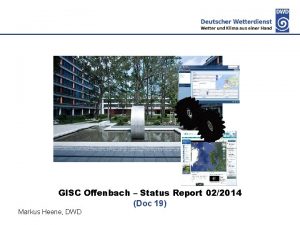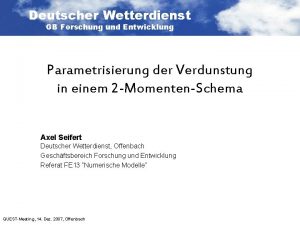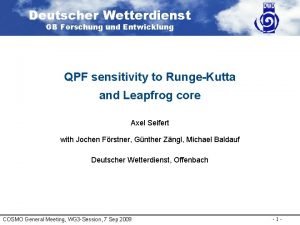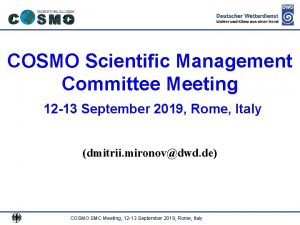WG 1 Overview christoph schraffdwd de Deutscher Wetterdienst





























- Slides: 29

WG 1 Overview christoph. schraff@dwd. de Deutscher Wetterdienst, D-63067 Offenbach, Germany current DA method: nudging PP KENDA for km-scale EPS: LETKF radar-derived rain rates: • latent heat nudging LETKF for HRM (final setup) Long-term impact of LHN assimilation on soil moisture ? KENDA & WG 1 Overview COSMO GM, Rome, 6 September 2011 christoph. schraff@dwd. de 1 26. 11. 2020 *

impact of LHN on soil moisture Experiment: 18 months (April 2009 – August 2010) COSMO-DE without LHN compare with operational COSMO-DE with LHN differences in normalised soil moisture (LHN - no. LHN) inside radar data domain June 2010 KENDA & WG 1 Overview COSMO GM, Rome, 6 September 2011 christoph. schraff@dwd. de 2 26. 11. 2020 *

impact of LHN on soil moisture: impact on surface parameters June 2010, 12 UTC runs BIAS LHN no. LHN bias reduced for different parameters KENDA & WG 1 Overview COSMO GM, Rome, 6 September 2011 christoph. schraff@dwd. de 3 26. 11. 2020 *

impact of LHN on soil moisture: impact on surface parameters monthly relative forecast skill 30% T_2 m Summer March 2009 (1 – rmse(LHN) / rmse(no. LHN)) 35% model runs Winter dew point depression Td_2 m Summer Aug 2010 LHN higher soil moisture content improved T-2 m , Td-2 m forecasts, benefit lasts over whole forecast time KENDA & WG 1 Overview COSMO GM, Rome, 6 September 2011 christoph. schraff@dwd. de 4 26. 11. 2020 *

WG 1 Overview christoph. schraff@dwd. de Deutscher Wetterdienst, D-63067 Offenbach, Germany PP KENDA for km-scale EPS: LETKF current DA method: nudging radar-derived rain rates: • latent heat nudging • 1 DVar (comparison) radar radial wind: • VAD (at DWD: no benefit) • nudg. Vr (being implemented) GPS-IWV (ceased) LETKF for HRM (final setup) Satellite radiances: • 1 DVAR: AMSU-A, SEVIRI, IASI (no benefit) • spatial AMSU-A obs errors statistics Vadim Gorin, Mikhail Tsyrulnikov: Estimation of multivariate observation-error statistics for AMSU-A data (MWR, accepted) screen-level: • scatterometer wind (OSCAT, Ocean. Sat 2) • improved T 2 m assimilation, adapt T_soil surface (snow …) PP COLOBOC KENDA & WG 1 Overview COSMO GM, Rome, 6 September 2011 daytime biases in summer: • Vaisala RS-92 humidity obs dry bias correction operational • model warm bias (low levels) christoph. schraff@dwd. de 5 26. 11. 2020 *

Status Overview on PP KENDA Km-scale ENsemble-based Data Assimilation christoph. schraff@dwd. de Deutscher Wetterdienst, D-63067 Offenbach, Germany Contributions / input by: Hendrik Reich, Andreas Rhodin, Roland Potthast, Uli Blahak, Klaus Stephan (DWD) Annika Schomburg (DWD / Eumetat) Yuefei Zeng, Dorit Epperlein (KIT Karlsruhe) Daniel Leuenberger, Manuel Bischof (Meteo. Swiss) Mikhail Tsyrulnikov, Vadim Gorin (HMC) Lucio Torrisi (CNMCA) Amalia Iriza (NMA) • Task 1: General issues in the convective scale (e. g. non-Gaussianity) • Task 2: Technical implementation of an ensemble DA framework / LETKF • Task 3: Tackling major scientific issues, tuning, comparison with nudging • Task 4: Inclusion of additional observations in LETKF KENDA & WG 1 Overview COSMO GM, Rome, 6 September 2011 christoph. schraff@dwd. de 6 26. 11. 2020 *

Task 2: Technical implementation of an ensemble DA framework / LETKF analysis step (LETKF) outside COSMO code ensemble of independent COSMO runs up to next analysis time separate analysis step code, LETKF included in 3 DVAR code of DWD collect obs from ]tana– 3 h , tana] old setup: obs from ]tana– 1. 5 h , tana+1. 5 h] thinned KENDA & WG 1 Overview COSMO GM, Rome, 6 September 2011 christoph. schraff@dwd. de 7 26. 11. 2020 *

Task 2: Technical implementation of an ensemble DA framework / LETKF • modifications in COSMO fully implemented, but not yet in official code (also in order to have a sub-hourly update frequency) • first version LETKF (KENDA) implemented in NUMEX, to be tested still use scripts to do a few stand-alone cycles with LETKF • deterministic analysis implemented • LBC at analysis time : use (perturbed) analysis ensemble member itself instead of (temporally interpolated) LBC fields from steering ensemble system • next step: talk of Hendrik LBC from GME LETKF ensemble interpolate GME ensemble perturbations and add to deterministic COSMO-DE LBC KENDA & WG 1 Overview COSMO GM, Rome, 6 September 2011 christoph. schraff@dwd. de 8 26. 11. 2020 *

Analysis for a deterministic forecast run : use Kalman Gain K of analysis mean deterministic analysis recently implemented L : interpolation of analysis increments from grid of LETKF ensemble to (possibly finer) grid of deterministic run ensemble deterministic • deterministic run must use same set of observations as the ensemble system ! • Kalman gain / analysis increments not optimal, if deterministic background x. B (strongly) deviates from ensemble mean background KENDA & WG 1 Overview COSMO GM, Rome, 6 September 2011 christoph. schraff@dwd. de 9 26. 11. 2020 *

Task 2: Technical implementation: verification for KENDA ‘stat’-utility: compute model (forecast) – obs for complete NEFF (Net. CDF feedback files) : adapt verification mode of 3 DVar/LETKF package need to implement COSMO observation operators with QC in 3 DVar/LETKF package ( hybrid 3 DVar–En. KF approaches in principle applicable to COSMO ) build COSMO modules with clean interfaces & introduce them in LETKF • no further progress • still plan to first implement upper-air obs (needed as input for VERSUS) KENDA & WG 1 Overview COSMO GM, Rome, 6 September 2011 christoph. schraff@dwd. de 10 26. 11. 2020 *

Task 2: Technical implementation: verification for KENDA NEFFprove (Amalia Iriza, NMA) : tool to compute and plot verification scores based on Net. CDF feedback files (NEFF) • computes statistical scores for different runs (‘experiments’), focus: use exactly the same observation set in each experiment ! select obs according to namelist values (area, quality + status of obs, … ) • compute scores (upper-air obs, screen-level obs, RR, cloud, etc. ) (for each experiment, variable, forecast time, vertical level, …) - deterministic continuous: BIAS, RMSE, MSE - dichotomous: accuracy, Heidke Skill Score, Hanssen and Kuiper discriminant - ensemble scores (to be done): reliability, ROC, Brier Skill Score, (continuous) Ranked Probability Score • plot the scores, using GNUplot (work is in progress) KENDA & WG 1 Overview COSMO GM, Rome, 6 September 2011 christoph. schraff@dwd. de 11 26. 11. 2020 *

Task 3: scientific issues & refinement of LETKF – lack of spread: (partly ? ) due to model error and limited ensemble size which is not accounted for so far to account for it: covariance inflation, what is needed ? multiplicative (tuning, or adaptive (y – H(x) ~ R + HTPb. H)) additive ((e. g. statistical 3 DVAR-B), stochastic physics (Torrisi)) – localisation (multi-scale data assimilation, 2 successive LETKF steps with different obs / localisation ? ) talk by Hendrik Reich – model bias – update frequency : up to now only 3 -hourly – non-linear aspects, convection initiation (latent heat nudging ? ) – technical aspects: efficiency, system robustness (Nov. 2012: regular ‘pre-operational’ LETKF suite) KENDA & WG 1 Overview COSMO GM, Rome, 6 September 2011 christoph. schraff@dwd. de 12 26. 11. 2020 *

LETKF scientific issues / refinements: investigate idealised convection • investigate LETKF in Observing System Simulation Experiments (OSSE) – apply LETKF to idealized convective weather systems, tune LETKF settings (localization, covariance inflation) – quantify + reduce spin-up time to assimilate convective storm by LETKF Meteo. Swiss: plan for 2 -year project not accepted – however master thesis (5 months): Manuel Bischof, Meteo. Swiss perturbations of the storm environment for ensemble generation: – wind speed, temperature (low-level stability), and (low-level) humidity all suitable to perturb – meaningful perturbation amplitudes: 2 m/s, 0. 25 K, 2 % KENDA & WG 1 Overview COSMO GM, Rome, 6 September 2011 christoph. schraff@dwd. de 13 26. 11. 2020 *

LETKF scientific issues / refinements: model error estimation • stochastic physics (Palmer et al. , 2009) : by Lucio Torrisi, available Oct. 2011 KENDA & WG 1 Overview COSMO GM, Rome, 6 September 2011 christoph. schraff@dwd. de 14 26. 11. 2020 *

LETKF scientific issues / refinements: model error estimation • objective estimation and modelling of model (tendency) errors (not to be confused with forecast errors) M. Tsyrulnikov, V. Gorin (HMC Russia) 1. set up a (revised) stochastic model (parameterisation) for model error (ME) MEM : e = * Fphys(x) + eadd – involves stochastic physics ( * Fphys(x) ) and additive components eadd and includes multi-variate and spatio-temporal aspects – model error model parameters: (E( ), D(eadd)) 2. develop MEM Estimator : estimate parameters by fitting to statistics from real forecast (COSMO-RU-14) and observation (radiosonde) tendency data, using a revised (maximum likelihood based) method (tested using bootstrap) 3. develop ME Generator embedded in COSMO code 4. develop MEM Validator: exactly known ME in OSSE set-up, retrieve with MEM Estimator The reproducibility of the MEM parameters is not yet established ! KENDA & WG 1 Overview COSMO GM, Rome, 6 September 2011 christoph. schraff@dwd. de 15 26. 11. 2020 *

Task 4: use of additional observations Tasks 4. 1, 4. 2: use of radar obs • radar : assimilate 3 -D radial velocity and 3 -D reflectivity directly Uli Blahak (DWD), Yuefei Zeng, Dorit Epperlein (KIT Karlsruhe) 1. Implement full, sophisticated observation operators (by end 2011) – compute reflectivity from model values using Mie- or Rayleigh-scattering KENDA & WG 1 Overview COSMO GM, Rome, 6 September 2011 christoph. schraff@dwd. de 16 26. 11. 2020 *

Tasks 4. 1, 4. 2: use of radar obs : radar observation operator sub-domain 1 sub-domain 2 propagation of radar beam : ‘online’ depend. on refractive index, or approximate standard atmosphere MPP parallelisation: beam in an azimuthal slice has to be collected on 1 PE averaging over beam weighting function: weighted spatial mean over measuring volumn (cross-beam vertically / horizontally) KENDA & WG 1 Overview COSMO GM, Rome, 6 September 2011 christoph. schraff@dwd. de 17 26. 11. 2020 *

Tasks 4. 1, 4. 2: use of radar obs : radar observation operator without attenuation with attenuation of radar reflectivity by atmospheric gases + hydrometeors (using the extinction coefficients) KENDA & WG 1 Overview COSMO GM, Rome, 6 September 2011 christoph. schraff@dwd. de 18 26. 11. 2020 *

Task 4: use of additional observations Tasks 4. 1, 4. 2: use of radar obs • radar : assimilate 3 -D radial velocity and 3 -D reflectivity directly Uli Blahak (DWD), Yuefei Zeng, Dorit Epperlein (KIT Karlsruhe) 1. implement full, sophisticated observation operators (by end 2011) 2. apply / test sufficiently accurate and efficient approximations – by looking at the simulated obs (by March 2012) – doing assimilation experiments : OSSE setup KENDA & WG 1 Overview COSMO GM, Rome, 6 September 2011 christoph. schraff@dwd. de 19 26. 11. 2020 *

Task 4. 3: use of GNSS slant path delay • ground-based GNSS slant path delay (early 2012, N. N. ) – implement non-local obs operator in parallel model environment – test and possibly compare with using GNSS data in the form of IWV or of tomographic refractivity profiles Particular issue: localisation for (vertically and horizontally) non-local obs KENDA & WG 1 Overview COSMO GM, Rome, 6 September 2011 christoph. schraff@dwd. de 20 26. 11. 2020 *

Task 4. 4: use of cloud info • cloud information based on satellite and conventional data Annika Schomburg (DWD / Eumetsat) – derive incomplete analysis of cloud top + cloud base, using conventional obs (synop, radiosonde, ceilometer) and NWC-SAF cloud products from SEVIRI – use obs increments of cloud or cloud top / base height or derived humidity – use SEVIRI brightness temperature directly in LETKF in cloudy (+ cloud-free) conditions, in view of improving the horizontal distribution of cloud and the height of its top – compare approaches Particular issues: non-linear observation operators, non-Gaussian distribution of observation increments KENDA & WG 1 Overview COSMO GM, Rome, 6 September 2011 christoph. schraff@dwd. de 21 26. 11. 2020 *

Task 4. 4: use of cloud info – make observations available – aggregation / interpolation to COSMO-DE / COSMO-EU grids – regular archiving: – NWC-SAF cloud products available since May 2011: (CT: cloud type, CTT: cloud top temperature, CTH: cloud top height) – BT available since June 2011: all 12 SEVIRI channels – assumption in LETKF: no bias look at systematic differences in BT / cloud products KENDA & WG 1 Overview COSMO GM, Rome, 6 September 2011 christoph. schraff@dwd. de 22 26. 11. 2020 *

Task 4. 4: use of cloud info BT high clouds: cold bias of model-BT, (partly ? ) due to known bias in RTTOV-9 KENDA & WG 1 Overview COSMO GM, Rome, 6 September 2011 christoph. schraff@dwd. de 23 26. 11. 2020 *

Task 4. 4: use of cloud info NWC-SAF SEVIRI cloud products: example cloud type CT cloud top height CTH fractional water clds high semitransparent very high clouds medium clouds low clouds very low clouds cloud-free water cloud-free land undefined COSMO: cloud water qc > 0 , or cloud ice qi > 5. 10 -5 kg/kg clc = 100 % subgrid-scale clouds clc = f(RH; shallow convection; qi , qi, sgs) < 100 % KENDA & WG 1 Overview COSMO GM, Rome, 6 September 2011 christoph. schraff@dwd. de 24 26. 11. 2020 *

Task 4. 4: use of cloud info cloud top height CTH distribution May – July 2011 clc > 1% clc > 20% NWC-SAF CTH ‘obs’ COSMO CTH for clc > x % clc > 50% clc > 70% KENDA & WG 1 Overview COSMO GM, Rome, 6 September 2011 clc > 90% christoph. schraff@dwd. de 25 26. 11. 2020 *

Task 4. 4: use of cloud info cloud top height CTH distribution NWC-SAF CTH ‘obs’ COSMO CTH with optimal threshold: KENDA & WG 1 Overview COSMO GM, Rome, 6 September 2011 May – July 2011 for clc > 70 % for levels above 5000 m , for clc > 40 % for levels below 5000 m christoph. schraff@dwd. de 26 26. 11. 2020 *

Task 4. 4: use of cloud info CTH COSMO 6 -h forecast, for 18 May 2011, 18 UTC clc > 0. 1% clc > 30% clc > 50% optimal clc > 70% clc > 90% cloud cover [%] , shading: model isoline: CTH MSG height [km] KENDA & WG 1 Overview COSMO GM, Rome, 6 September 2011 christoph. schraff@dwd. de 27 26. 11. 2020 *

Technical implementation of verification for KENDA thank you for your attention KENDA & WG 1 Overview COSMO GM, Rome, 6 September 2011 christoph. schraff@dwd. de 28 26. 11. 2020 *

Local Ensemble Transform Kalman Filter LETKF (Hunt et al. , 2007) +( +( ensemble mean forecast - ) ) k perturbed ensemble forecasts mean fcst. 0. 9 Pert 1 -0. 1 Pert 2 -0. 1 Pert 3 -0. 1 Pert 4 local transform matrix w forecast perturbations Xb flow-dep background error cov. Pb = (k – 1) X b (X b )T +( +( analysis mean analysis error covariance (computed only in ensemble space) - ) ) analysis Wa(i) perturbations perturbed analyses in the (k-1) -dimensional (!) sub-space S spanned by background perturbations : set up cost function J(w) in ensemble space, explicit solution for minimisation (Hunt et al. , 2007) KENDA & WG 1 Overview COSMO GM, Rome, 6 September 2011 christoph. schraff@dwd. de 29 26. 11. 2020 *
 Deutsche nationalhymne text strophe 1-3
Deutsche nationalhymne text strophe 1-3 Deutscher schmerzfragebogen muster
Deutscher schmerzfragebogen muster Andreas martin du bist alles
Andreas martin du bist alles Wärmebedarfsberechnung excel kostenlos
Wärmebedarfsberechnung excel kostenlos Dve definition
Dve definition Deutscher gründerpreis für schüler aufgaben
Deutscher gründerpreis für schüler aufgaben Personalwirtschaftspreis
Personalwirtschaftspreis Deutscher aberglaube
Deutscher aberglaube Manfred baudisch rostock
Manfred baudisch rostock Personalausweis satan
Personalausweis satan Faktoren industrialisierung england
Faktoren industrialisierung england Bundesverbandes deutscher gartenfreunde
Bundesverbandes deutscher gartenfreunde Daniel nauck
Daniel nauck Deutscher basketball bund regeln
Deutscher basketball bund regeln Deutscher erfinder des telefons
Deutscher erfinder des telefons Amanda hurtado
Amanda hurtado Afreth reviews
Afreth reviews Christoph blume
Christoph blume Christoph rembser
Christoph rembser Prof. dr. christoph gröpl
Prof. dr. christoph gröpl Dr. christoph weiss
Dr. christoph weiss Stoa christoph
Stoa christoph Dr oneta winterthur
Dr oneta winterthur Christoph grünenwald
Christoph grünenwald Christoph gort
Christoph gort Christoph hertrich
Christoph hertrich Anfallsgeschehen
Anfallsgeschehen Jan christoph pfeiffer
Jan christoph pfeiffer Berufsfachschule langenthal
Berufsfachschule langenthal Christoph hessler
Christoph hessler
